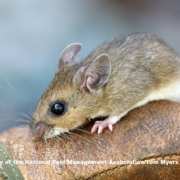Types of Mice
House Mice (Mus domesticus)
The house mouse is the most common rodent pest in most parts of the world. It can breed rapidly and adapt quickly to changing conditions. In fact, a female house mouse can give birth to a half dozen babies every three weeks, and can produce up to 35 young per year.
Elite Pest Management, LLC-Bed Bug and Termite Services
Color
Dusty gray with a cream belly
| Legs | 4 |
|---|---|
| Antennae | No |
| Region | Found throughout the U.S. and world. |
Shape
Round
Size
2.5-3.75 inches long
Habits
House mice prefer to eat seeds and insects, but will eat many kinds of food. They are excellent climbers and can jump up to a foot high, however, they are color blind and cannot see clearly beyond six inches.
Habitat
House mice live in structures, but they can survive outdoors, too. House mice prefer to nest in dark, secluded areas and often build nests out of paper products, cotton, packing materials, wall insulation and fabrics.
Threats
Micro droplets of mouse urine can cause allergies in children. Mice can also bring fleas, mites, ticks and lice into your home.
House Mice Prevention
To keep mice and other rodents out, make sure all holes of larger diameter than a pencil are sealed. Keep areas clear and store boxes off of the floor because mice can hide in clutter. Don’t overlook proper drainage at the foundation and always install gutters or diverts which will channel water away from the building to prevent ideal conditions in which house mice can nest. Regularly inspect the home for signs of mice including droppings, gnaw marks and damaged food goods. If you suspect a rodent infestation, contact a licensed rodent pest control professional to treat and get rid of house mice.
Deer Mice (Peromyscus maniculatus)
The deer mouse is found in rural, outdoor areas. These rodents rarely invade residential homes, but they can be a problem in farming areas, vacation homes, outbuildings and sheds. Deer mice are of medical concern because they are common carriers of Hantavirus.
Elite Pest Management, LLC-Bed Bug and Termite Services
Color
Brown, with white feet and underbelly
| Legs | 4 |
|---|---|
| Antennae | No |
| Region | Found throughout the U.S. |
Shape
Round
Size
5-8 inches long
Habits
The deer mouse feeds at dusk and dawn, preferring insects, seeds, nuts, berries and small fruits.
Habitat
Deer mice often nest in sheltered outdoor areas such as old fence posts, hollow tree logs or piles of debris. During the winter months, deer mice may invade homes, garages, sheds or rarely used vehicles to seek shelter. Inside, attics and basements make the ideal deer mouse habitat. The deer mouse also builds its nest in storage boxes, stuffed furniture, drawers and wall voids.
Threats
The deer mouse transmits the potentially fatal Hantavirus Pulmonary Syndrome. The disease can be transmitted through contact with mouse carcasses, or by breathing in aerosolized urine droplets of infected deer mice.
Deer Mice Prevention
To keep deer mice and other rodents out, make sure all holes of larger diameter than a pencil are sealed. Mice can squeeze through spaces as small as a dime. Seal any cracks and voids. Don’t overlook proper drainage at the foundation and always install gutters or diverts which will channel water away from the building. Use heavy gloves and protective breathing gear when working in an area populated by deer mice.













